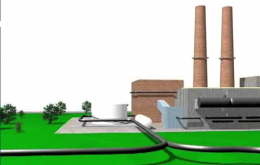Carbon sequestration may enhance energy production, researchers say

(�鶹��ԺOrg.com) -- As energy consumption and greenhouse gas emissions continually rise in the United States, unconventional natural gas sources coupled with advances in carbon sequestration may be the solution, according to Stanford University scientists.
“In the next 30 years, we want to transition away from fossil fuels and move towards stabilizing atmospheric carbon,” said Mark Zoback, a professor of geophysics at Stanford. “The utilization of unconventional natural gas with carbon capture and storage is a great way to get from here to there.” Zoback presented his comments at a recent Energy Seminar hosted by Stanford’s Woods Institute for the Environment and Precourt Institute for Energy.
Natural gas, which is comprised almost entirely of methane, provides 22 percent of United States energy needs and emits about half as much greenhouse gas as coal, according to the Department of Energy. More than 50 percent of the natural gas comes from conventional sources, such as oil deposits, while the rest comes from unconventional sources, such as shale, coal bed methane (gas extracted from coal beds) and tight gas (gas extracted from relatively impermeable sandstone).
Pulling gas from dense shale or sandstone is no easy task, but increases in oil prices and growing concern about reducing carbon emissions have led the energy industry to consider these alternatives, Zoback said. And the reserves are big. The U.S. alone has enough natural gas to last nearly a century at current production levels, according to the Potential Gas Committee, a nonprofit organization with members from industry, government and academia.
“Unconventional gas production is going to happen,” Zoback said. “The resources are too big, they’re domestic, they’re close to existing pipelines and they’re clean compared to the alternatives.”
Any new gas production should be coupled with carbon sequestration to help reduce carbon dioxide (CO2) emissions, he said. And in the case of coal bed methane, sequestration may actually increase methane production, according to work by Zoback and former Stanford researchers Hannah Ross and Paul Hagin. Their results are scheduled to be published in the International Journal of Greenhouse Gas Control.
Energy-saving solutions
According to the United Nations International Panel on Climate Change, electricity-generating power plants are responsible for about one-third of carbon emissions worldwide. Those emissions could be reduced 80 to 90 percent by trapping the CO2 gas and permanently sequestering it deep underground or in the ocean—a process referred to as carbon capture and storage.
Yet carbon sequestration has been criticized, in part because compressing and storing CO2 is energy intensive and might drive up consumer costs. Others have voiced concern that the CO2 could eventually leak from storage areas.
To investigate the potential of combining carbon storage with coal bed methane extraction, Ross, Hagin and Zoback generated a computer model using data from the Power River Basin of Wyoming, where there are 18,000 active coal bed methane wells and another 50,000 planned for the next decade.
In some regions where coal lies trapped below the surface, groundwater flows over and around the deposits forming fractures. Bacteria that live naturally in the water attach themselves to the coal and consume it. As they dine, the bacteria form and release methane gas as a byproduct, which then forms a film that clings to the surface of the coal. To remove the methane from the coal, industry professionals drill a well into the coal fractures and pump out the groundwater. The depressurized methane is then piped to the surface and used as natural gas.
Zoback and colleagues wanted to see what would happen if they created a computer model that sequestered CO2 while extracting the methane. “Coal adsorbs carbon dioxide more than methane,” Zoback explained. When the researchers injected carbon dioxide into a computer-generated coal bed, the coal readily adsorbed the CO2, pushing out the methane gas. What’s more, the computer model projected that 99 percent of the CO2 would stay chemically bound to the coal. After five years of production, five to eight times more methane could be extracted using carbon sequestration, according to the model.
“The idea is to think about carbon sequestration along with the development of shale gases,” Zoback said. “And with coal bed methane, doing carbon capture and storage may actually enhance coal bed methane ����ǻ�ܳ��پ��Dz�.”
This research is just one example of how CO2 sequestration could be incorporated into unconventional gas production, he added. “We are at the beginning of something that’s going to take off,” Zoback said. “If it’s going to happen, let’s do it right and build in carbon sequestration from the outset.”
Financial support for Zoback’s work is provided by Stanford’s Global Climate and Energy Project, Stanford Rock �鶹��Ժics and Borehole Geophysics Project Consortium, ConocoPhillips, Chevron and British Petroleum.
Provided by Stanford University















